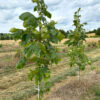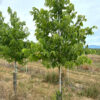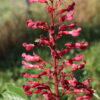
Ilex opaca, the American holly, is a medium-sized broadleaf evergreen tree, typically ranging in size from 20-30 ft tall in northern parts of its range to sixty feet or more in the subtropics. It may be found in the wild from coastal Massachusetts south to central Florida and the Gulf coast and west to the junction of the Ohio and Mississippi rivers. It is one of original cultivated natives of North America, with specimens planted in Pennsylvania, Massachusetts and Virginia since the 1600s.
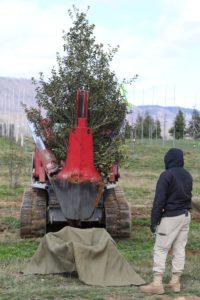
In much of its native range, I. opaca appears frequently as an understory tree in mixed deciduous forests or in swampy lowlands, but can also be found in isolation in fields and on protected dunes. Adaptable to a wide variety of soils, it performs best in rich, moist, well-drained acidic soils, disliking both standing water and salts. The stiff, spiny, leathery leaves are 2-4” long and half as wide with a deep matte or semi-gloss green color above and a pale dull green below. The leaves are distinctly less shiny than many other treeform hollies—particularly the glossy type-species for the genus, I. aquifolium, the English holly—hence the specific epithet opaca, meaning ‘dull’ in Latin. Clusters of lightly-fragrant inconspicuous greenish-white flowers are borne in spring; as with most hollies, I. opaca is dioecious, with specific plants being either male or female. The female plants bear masses of small red berries in winter, which are a key attraction of the plant in the landscape. The fruits typically persist through the winter unless devoured by birds and animals; they are a key nutrition source for many species. Once a particular plant is ‘discovered’, birds or squirrels can strip a plant bare of fruit in hours or days. It is a particular favorite of cedar waxwings (Bombycilla cedrorum), flocks of which often seek out hollies on their migrations north in late winter and early spring. Of note in the landscape; the fruit is toxic to humans; ingestion of berries can cause nausea, diarrhea, and severe stomach pain.
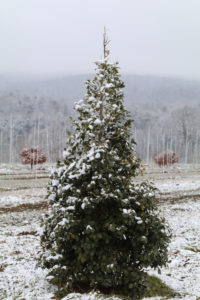
In the landscape, American holly can serve a variety of roles: as a specimen, a backdrop for the shrub or perennial border, or as an accent understory plant in wooded areas on larger properties. In a Virginia landscape, it will typically mature at 25-35 feet in height with a dense, irregularly pyramidal form. The attractive bark is a smooth pale grey throughout its life and the slender flexible branches resist ice, snow, and storm damage better than many other woody plants. In Virginia, it is best sited with some shade from the midsummer sun and protection from desiccating winter winds. The plant has few pests aside from the mites and scale that can affect most broadleaf evergreens and occasional leaf spot in damp, humid weather. Trees in the landscape can become chlorotic due to iron deficiency. Presenting as greenish-yellow leaves with dark green veins, chlorosis can be controlled by sulfur, acidifying fertilizers, or iron chelate.
Aside from its value as a wildlife food source and in the garden, the dried berries of American holly were an important barter item for certain Native American groups due to their usefulness as buttons. The wood of I. opaca is hard, close-grained and off-white in color, making it useful for cabinetry and engraving blocks. It also strongly absorbs stain, even black stains, and so can be used as a substitute for ebony in inlays.
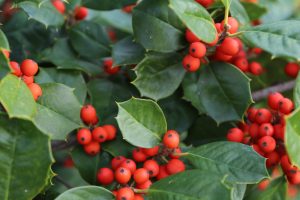
White House Natives supplies Ilex opaca in sizes from five to ten feet. As a year-round ornamental and a wildlife food source, it has a place in virtually every landscape.




